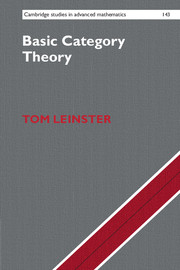Book contents
5 - Limits
Published online by Cambridge University Press: 05 August 2014
Summary
Limits, and the dual concept, colimits, provide our third approach to the idea of universal property.
Adjointness is about the relationships between categories. Representability is a property of set-valued functors. Limits are about what goes on inside a category.
The concept of limit unifies many familiar constructions in mathematics. Whenever you meet a method for taking some objects and maps in a category and constructing a new object out of them, there is a good chance that you are looking at either a limit or a colimit. For instance, in group theory, we can take a homomorphism between two groups and form its kernel, which is a new group. This construction is an example of a limit in the category of groups. Or, we might take two natural numbers and form their lowest common multiple. This is an example of a colimit in the poset of natural numbers, ordered by divisibility.
Limits: definition and examples
The definition of limit is very general. We build up to it by first examining some particularly useful types of limit: products, equalizers, and pullbacks.
Products
Let X and Y be sets. The familiar cartesian product X χ Y is characterized by the property that an element of X χ Y is an element of X together with an element of Y.
Information
- Type
- Chapter
- Information
- Basic Category Theory , pp. 107 - 140Publisher: Cambridge University PressPrint publication year: 2014
